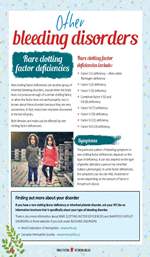Other bleeding disorders
Rare clotting factor deficiencies
Rare clotting factor deficiencies are another group of inherited bleeding disorders, caused when the body does not produce enough of a certain clotting factor, or when the factor does not work properly. Less is known about these disorders because they are very uncommon. In fact, many have only been discovered in the last 40 years.
Rare clotting factor deficiencies include:
- Factor I (1) deficiency – often called fibrinogen deficiency
- Factor II (2) deficiency
- Factor V (5) deficiency
- Combined factor V (5) and VIII (8) deficiency
- Factor VII (7) deficiency
- Factor X (10) deficiency
- Factor XI (11) deficiency
- Factor XIII (13) deficiency.
The particular pattern of bleeding symptoms in rare clotting factor deficiencies depends on the type of deficiency. It can also depend on the type of genetic alteration a person has inherited (called a phenotype). In some factor deficiencies, the symptoms can also be mild, moderate or severe depending on the amount of factor in the person’s blood.
Inheritance
Most of these conditions are inherited in what is known as an autosomal recessive pattern (like the inheritance pattern for VWD . This means that the person with the rare factor deficiency has nearly always inherited an altered gene from both parents. Some are found more often in areas of the world or communities where marriage between close relatives is common. In other families, parents may not be aware that they have the gene because they have few or no symptoms and it can be very unexpected when their child is diagnosed.
Exceptions are factor XI (11) deficiency and some types of factor I (1) deficiency, which can be inherited in either an autosomal recessive or autosomal dominant pattern (like the VWD inheritance patterns).
Inherited platelet function disorders
Examples of inherited platelet function disorders are:
- Glanzmann's Thrombasthenia
Affects the fibrinogen receptor
- Bernard-Soulier syndrome
Affects the von Willebrand factor (VWF) receptor
In platelet function disorders, the platelet plug does not form properly, leading to a tendency to bleed for longer than normal or bruise easily. Since platelets have many roles in blood clotting, platelet function disorders can cause bleeding that ranges from mild to severe.
Acquired haemophilia and VWD
Nearly all people with haemophilia and von Willebrand disease (VWD) are born with these health conditions. These are called inherited bleeding disorders. However, a person can develop a different kind of haemophilia or VWD throughout life, usually as an adult, although this is very rare. This is known as an acquired bleeding disorder.
Acquired haemophilia can occur when a person’s immune system produces antibodies that mistakenly target their own factor VIII. It is very rare but can sometimes occur in older people and young women who are in the later stages of pregnancy or have recently given birth. The bleeding pattern is different to inherited haemophilia and it is usually curable with treatment.
Acquired von Willebrand disease can also occur but is extremely rare.
Acquired bleeding disorders are not inherited or passed on to children. Men and women are equally likely to be affected by an acquired bleeding disorder.
Finding out more about your disorder
If you have a rare clotting factor deficiency or inherited platelet disorder, ask your Haemophilia Treatment Centre for an information brochure that is specifically about your type of bleeding disorder.
There is also more information about RARE CLOTTING FACTOR DEFICIENCIES and INHERITED PLATELET DISORDERS on these websites if you look under BLEEDING DISORDERS:
Contact details of Haemophilia Treatment Centres in Australia are available on the HFA website

If you’d like to know more about other bleeding disorders download our Female Factors – Other bleeding disorders resource here. This contains more information on:
- Rare clotting factor deficiencies
- Inherited platelet function disorders
- Acquired haemophilia and VWD

For more information on bleeding disorders in young women read our full Female Factors resource here